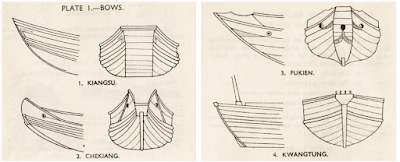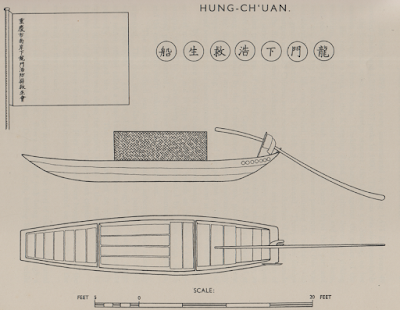 |
| Bow typology of Chinese junks, from A Classification of the Principal Chinese Sea-going Junks by Worcester (1948). |
Continuing our series of free downloads of books about Asian watercraft, we are pleased to offer the useful A Classification of the Principal Chinese Sea-going Junks (South of the Yangtze), by G.R.G. Worcester, made available to us by a contributor who wishes to remain anonymous. The book was published by China's Inspectorate General of Customs in 1948.
Focusing entirely on sailing craft, Worcester identifies 93 junk types in the area of study. Few of them are less than 50' (about 15m) LOA and some are well over 100' (30m). His guide to identification relies on three main characteristics. In order of importance they are: bow shape; stern shape, and (surprisingly), decoration and color scheme, which, he says, are highly characteristic of the region in which each type is found. Also suprising is that he lists the rig as a characteristic of secondary importance, less significant in identification than color and decoration. His typology for the main bow types is shown above.
Each type is depicted on a two-page spread, with the left page bearing a profile drawing of the ship above the waterline, including its rig. The right-hand page is consistently formatted with details of design, locale, and usage, as shown in the example below.
 |
| Yencheng Trader-type junk, an example of the type descriptions in A Classification of the Principal Chinese Sea-going Junks by Worcester (1948). |
Other books on Chinese and East Asian watercraft are available for free download on this page, including other works by Worcester.










